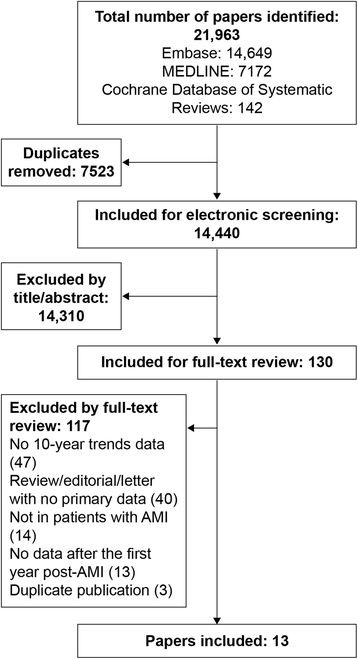Mortality and morbidity trends after the first year in survivors of acute myocardial infarction: a systematic review
- PMID: 28173750
- PMCID: PMC5297173
- DOI: 10.1186/s12872-017-0482-9
Mortality and morbidity trends after the first year in survivors of acute myocardial infarction: a systematic review
Abstract
Background: Most studies of outcomes after myocardial infarction (MI) focus on the acute phase after the index event. We assessed mortality and morbidity trends after the first year in survivors of acute MI, by conducting a systematic literature review.
Methods: Literature searches were conducted in Embase, MEDLINE, and the Cochrane Database of Systematic Reviews to identify epidemiological studies of long-term (>10 years) mortality and morbidity trends in individuals who had experienced an acute MI more than 1 year previously.
Results: Thirteen articles met the inclusion criteria. Secular trends showed a consistent decrease in mortality and morbidity after acute MI from early to more recent study periods. The relative risk for all-cause death and cardiovascular outcomes (recurrent MI, cardiovascular death) was at least 30% higher than that in a general reference population at both 1-3 years and 3-5 years after MI. Risk factors leading to worse outcomes after MI included comorbid diabetes, hypertension and peripheral artery disease, older age, reduced renal function, and history of stroke.
Conclusions: There have been consistent improvements in secular trends for long-term survival and cardiovascular outcomes after MI. However, MI survivors remain at higher risk than the general population, particularly when additional risk factors such as diabetes, hypertension, or older age are present.
Keywords: Long-term; Morbidity; Mortality; Myocardial infarction; Risk factors.
Figures
References
-
- Mozaffarian D, Benjamin EJ, Go AS, Arnett DK, Blaha MJ, Cushman M, de Ferranti S, Despres JP, Fullerton HJ, Howard VJ, et al. Heart disease and stroke statistics – 2015 update: a report from the American Heart Association. Circulation. 2015;131(4):e29–322. doi: 10.1161/CIR.0000000000000152. - DOI - PubMed
Publication types
MeSH terms
LinkOut - more resources
Full Text Sources
Other Literature Sources
Medical
Miscellaneous


